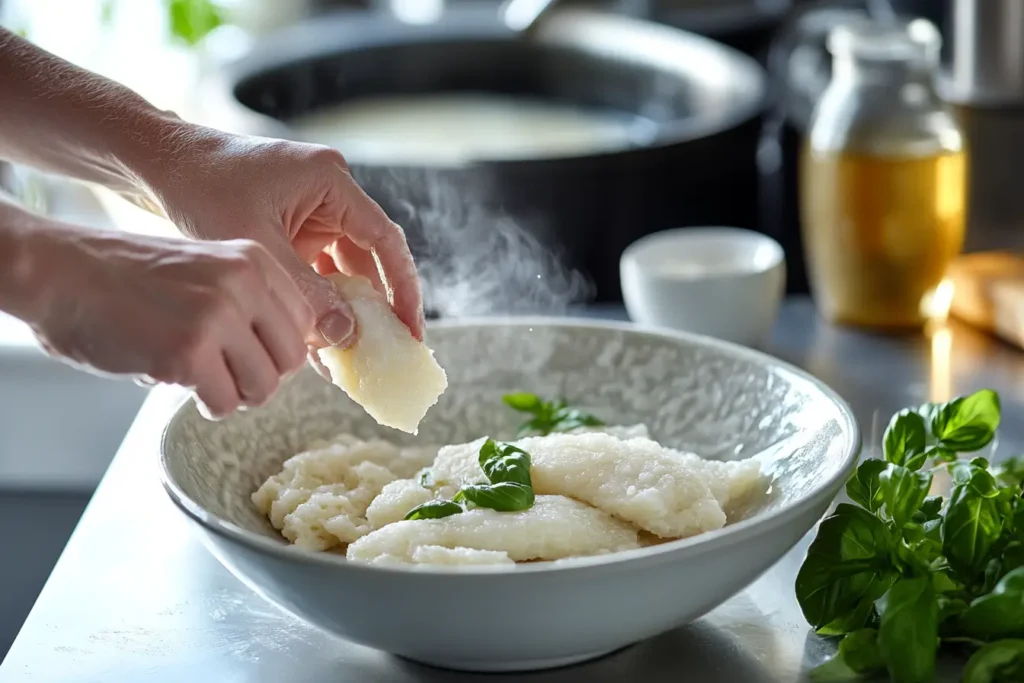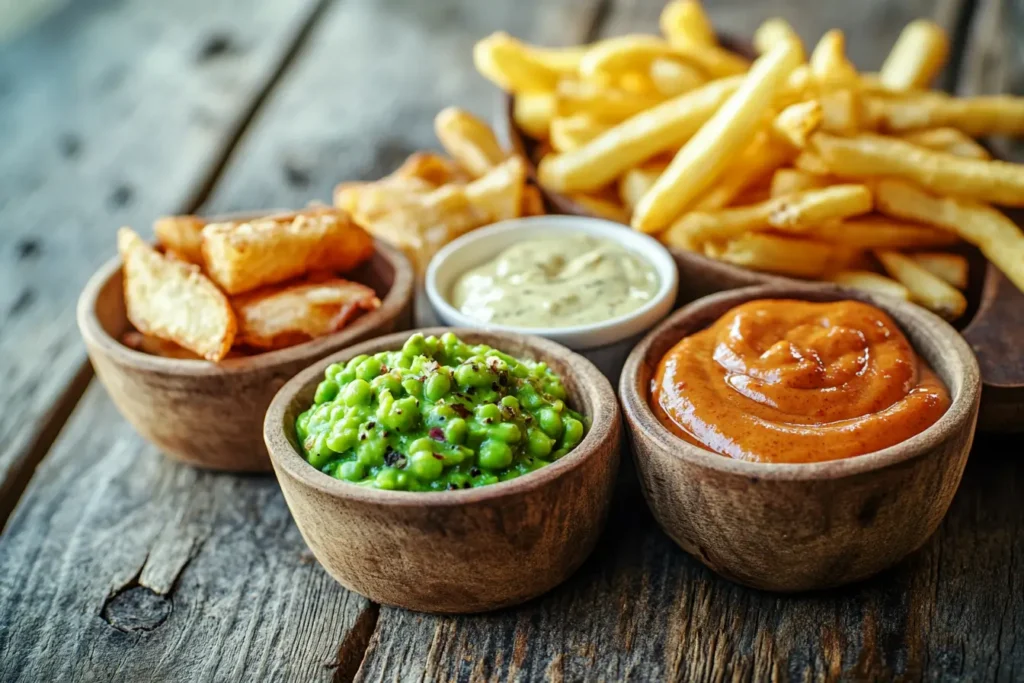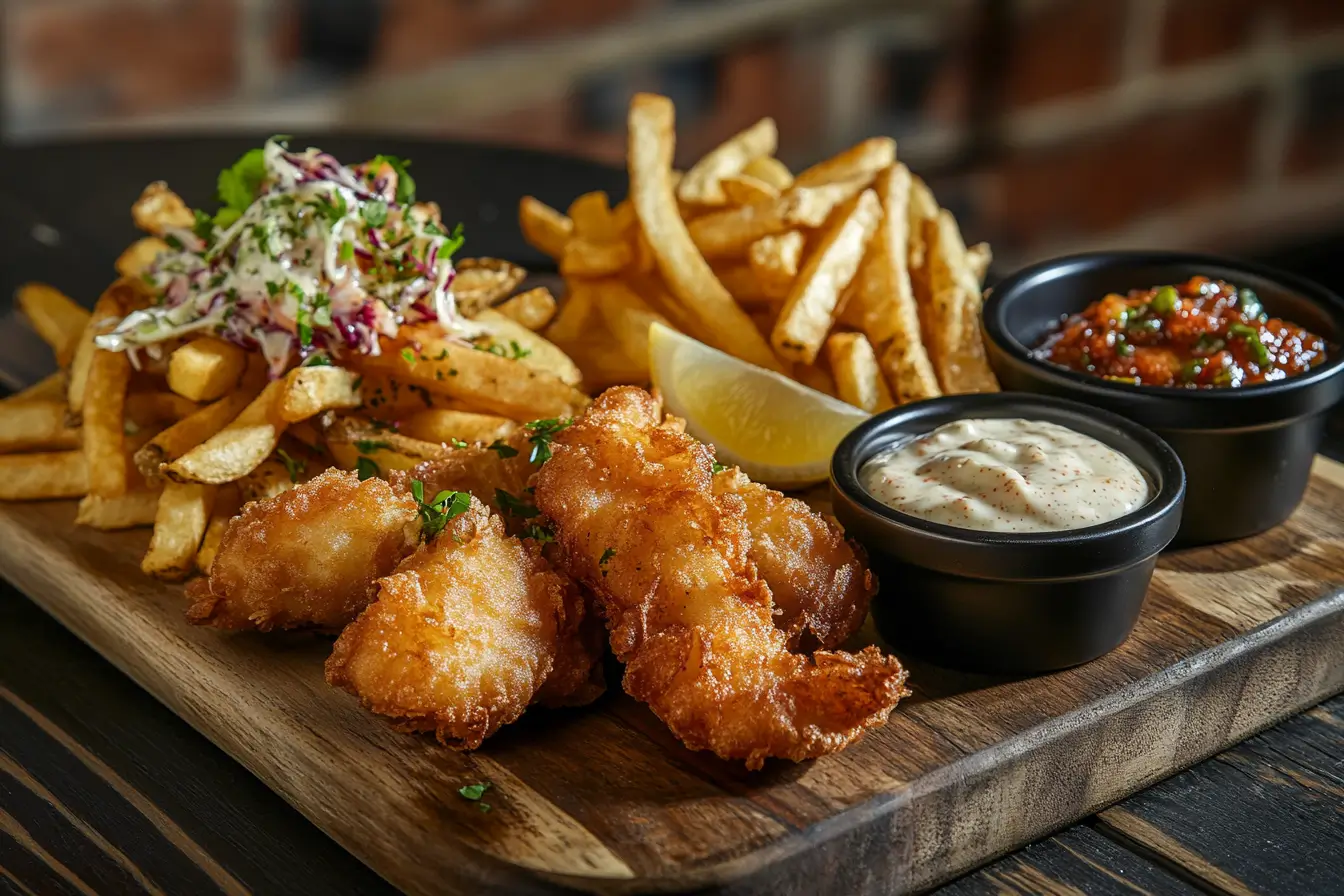Table of Contents
Introduction
Few dishes scream British comfort food quite like fish and chips. With its crispy, golden-battered fish and perfectly crunchy chips, this dish has stood the test of time as a beloved classic. Whether you’re making it for a family dinner, a weekend treat, or just craving some pub-style indulgence, a homemade fish and chips recipe will never disappoint.
In this guide, we’ll break down everything you need to know to make the perfect fish and chips from scratch. From choosing the right fish and mastering the batter to getting that ideal crisp on your chips, we’ve got you covered. Plus, we’ll explore healthier alternatives, classic condiments, and expert tips to make sure your dish turns out restaurant-quality every time.
Let’s dive right into the origins of this legendary dish before we start cooking!
Introduction to Fish and Chips
The History of Fish and Chips
Fish and chips didn’t just appear overnight—it has a rich history that dates back to the 19th century. While fried fish was introduced to England by Jewish immigrants from Portugal and Spain, the concept of pairing it with deep-fried potatoes emerged in working-class communities. By the 1860s, fish and chip shops were popping up all over Britain, feeding hungry laborers an affordable, satisfying meal.
Fast forward to today, and fish and chips remains an iconic British dish, enjoyed in seaside towns, bustling cities, and cozy pubs. Its simple yet addictive combination of crispy batter, flaky fish, and golden fries has made it a global favorite.
Why Fish and Chips is a Classic Dish
So, what makes fish and chips so special? It’s the perfect balance of textures and flavors:
- Crunchy batter that locks in moisture, keeping the fish tender and juicy.
- Flaky white fish, mild yet rich, that pairs beautifully with the crisp coating.
- Golden chips, thick-cut and twice-fried, for a fluffy interior and crispy exterior.
- Tangy condiments, from malt vinegar to tartar sauce, adding that extra punch of flavor.
Whether you enjoy it wrapped in newspaper, served in a takeaway box, or plated in a fine dining setting, fish and chips always delivers pure comfort.
What Makes the Perfect Fish and Chips?
If you want to recreate restaurant-style fish and chips at home, you need to focus on a few key elements:
✅ The Right Fish – Cod, haddock, or pollock work best for their mild flavor and flaky texture.
✅ Crispy Batter – A mix of flour, cornstarch, and a splash of beer or sparkling water makes for a light, crispy coating.
✅ Perfectly Fried Chips – Thick-cut potatoes fried twice—once at a lower temperature to cook through, then at a higher temp for a crispy finish.
✅ The Right Oil – Using oils like peanut, vegetable, or sunflower ensures deep-fried perfection without overpowering flavors.
✅ Condiments and Sides – No fish and chips recipe is complete without tartar sauce, malt vinegar, and mushy peas.
Now that you know why fish and chips is such a beloved dish, it’s time to get cooking! In the next part, we’ll discuss how to choose the best ingredients to ensure your fish and chips turn out spectacular.
BBC History – The Origins of Fish and Chips https://www.bbc.co.uk/news/uk-43210436
Choosing the Right Ingredients
Best Fish for Fish and Chips: Cod, Haddock, or Pollock?
The foundation of a great fish and chips recipe is choosing the right fish. Traditional options include:
✔ Cod – The most popular choice, known for its mild flavor and flaky texture.
✔ Haddock – Slightly sweeter than cod, with a firmer texture.
✔ Pollock – A budget-friendly alternative that still delivers a great taste.
These fish work well because they hold up to frying and complement the crispy batter beautifully. If you’re looking for a sustainable option, check seafood guides to find responsibly sourced fish.
The Secret to the Crispiest Batter – Flour, Beer, and Seasoning
A good batter should be light, airy, and crispy. The secret? Cold beer or sparkling water! The carbonation creates tiny air pockets, resulting in a delicate crunch. For the best texture, use a mix of:
- All-purpose flour – The base for structure.
- Cornstarch or rice flour – Enhances crispiness.
- Baking powder – Adds lightness.
- Beer or sparkling water – Creates an airy, crispy crust.
For seasoning, don’t just rely on salt—add a pinch of paprika, garlic powder, or cayenne for extra depth.
Which Oil is Best for Frying?
Deep frying requires an oil that can handle high heat. The best choices include:
🔥 Vegetable oil – A neutral taste and high smoke point.
🔥 Peanut oil – Enhances crispiness but adds a slight nutty flavor.
🔥 Sunflower or canola oil – Affordable and effective.
Avoid olive oil, as it burns quickly and alters the taste.
The Best Potatoes for Perfectly Crispy Chips
The perfect chip is fluffy inside and crispy outside. For this, use starchy potatoes like:
🥔 Russet potatoes – The classic choice with a high starch content.
🥔 Maris Piper (UK) – Ideal for that authentic British texture.
🥔 Yukon Gold – A slightly creamier option with a rich flavor.
Now that we have our ingredients sorted, let’s get into the step-by-step process of making the best fish and chips recipe at home!
Step-by-Step Fish and Chips Recipe

Preparing the Fish: Cleaning and Cutting
Before you start frying, prep your fish fillets properly:
1️⃣ Rinse the fillets and pat them dry with paper towels.
2️⃣ Cut them into even portions for uniform cooking.
3️⃣ Lightly dust them with flour before battering—this helps the batter stick.
Making the Perfect Batter: Tips for a Light, Crispy Coating
For the best batter, follow these tips:
✔ Keep all ingredients cold. This prevents the batter from absorbing too much oil.
✔ Whisk just until combined—overmixing makes it dense.
✔ Let the batter rest for 10–15 minutes before frying for a better texture.
How to Fry Fish for Maximum Crunch
1️⃣ Heat your oil to 350°F (175°C)—too hot, and the batter burns; too low, and it gets greasy.
2️⃣ Dip each fish fillet into the batter, ensuring full coverage.
3️⃣ Gently lower it into the oil and fry for 4–5 minutes, turning once.
4️⃣ Remove and drain on a wire rack (not paper towels, which can make it soggy).
Double-Frying Chips for the Perfect Crispness
To achieve crispy, golden chips, use the double-fry method:
1️⃣ First Fry: Cook at 300°F (150°C) for 3–4 minutes to soften them.
2️⃣ Let them cool for 10 minutes—this step is crucial!
3️⃣ Second Fry: Increase heat to 375°F (190°C) and fry again until golden and crispy.
Serving Suggestions – Traditional vs. Modern Twists
Classic fish and chips are served with:
✅ Malt vinegar for a tangy kick.
✅ Tartar sauce—creamy, tangy, and perfect for dipping.
✅ Lemon wedges to enhance freshness.
For a modern twist, try serving with:
🔥 Garlic aioli instead of tartar sauce.
🔥 Sweet potato fries for a unique take on chips.
🔥 Spicy sriracha mayo for an extra punch of flavor.
With your homemade fish and chips recipe perfected, you’re ready to enjoy crispy, golden goodness at home. Up next, we’ll explore alternative cooking methods for a healthier twist!
Serious Eats – Science of Frying for Crispy Food https://www.seriouseats.com/the-science-of-frying
Alternative Cooking Methods
Oven-Baked Fish and Chips for a Healthier Option
If you love fish and chips but want a healthier twist, baking is a great alternative. Instead of deep-frying, the fish and chips are cooked in the oven, using less oil while still achieving crispiness.
To make oven-baked fish:
1️⃣ Preheat your oven to 425°F (220°C).
2️⃣ Coat the fish fillets in a mix of panko breadcrumbs, flour, and seasoning.
3️⃣ Lightly spray with oil and bake for 15–18 minutes, flipping halfway.
For oven-baked chips:
1️⃣ Cut potatoes into thick fries and toss them with olive oil, salt, and paprika.
2️⃣ Spread them in a single layer on a baking sheet.
3️⃣ Bake for 25–30 minutes, flipping halfway for even crispiness.
This method still delivers a crunchy bite without the extra grease!
Air-Fryer Fish and Chips – A Modern Take
The air fryer is a game-changer for making crispy, golden fish with minimal oil. Here’s how:
🔥 Preheat the air fryer to 375°F (190°C).
🔥 Coat fish fillets in flour, egg wash, and breadcrumbs for an extra crunchy finish.
🔥 Cook for 10–12 minutes, flipping halfway, until crispy and golden.
For air-fried chips, toss sliced potatoes with a little oil and seasoning, then cook at 380°F (195°C) for 20–25 minutes, shaking the basket halfway.
Gluten-Free and Low-Carb Versions
If you’re avoiding gluten or want a low-carb alternative, try these substitutions:
✅ Use almond flour or cornmeal for a gluten-free batter.
✅ Swap breadcrumbs for crushed pork rinds or coconut flour.
✅ Replace regular potatoes with zucchini fries or turnip fries.
This way, you can enjoy a fish and chips recipe that fits your dietary needs without sacrificing flavor!
Classic British Condiments and Side Dishes

Homemade Tartar Sauce Recipe
No fish and chips recipe is complete without a creamy, tangy tartar sauce. Making it at home is simple:
🥄 Ingredients:
- ½ cup mayonnaise
- 1 tbsp chopped pickles
- 1 tsp Dijon mustard
- 1 tsp lemon juice
- ½ tsp capers (optional)
- Salt and pepper to taste
🥄 Instructions:
1️⃣ Mix all the ingredients in a bowl.
2️⃣ Adjust seasoning to taste.
3️⃣ Let it sit for 10 minutes to blend the flavors.
Mushy Peas – A British Classic
Mushy peas are a must-have side dish with fish and chips. This classic British accompaniment adds a fresh, slightly sweet contrast to the crispy, fried goodness.
To make mushy peas:
1️⃣ Boil 1 cup of peas in water for 5 minutes.
2️⃣ Drain and mash them with 1 tbsp butter, salt, and a squeeze of lemon juice.
3️⃣ For extra creaminess, add a splash of cream or milk.
Pickled Onions and Malt Vinegar: A Perfect Pairing
For a true British experience, drizzle your fish and chips with malt vinegar. The tanginess balances the rich, crispy batter perfectly.
Pickled onions add another layer of crunch and acidity, cutting through the oiliness and enhancing the flavors. If you love extra zing, try serving your dish with pickled gherkins or pickled eggs!
Ketchup, Curry Sauce, and Other Popular Condiments
While tartar sauce and vinegar are traditional, there are other condiments that can level up your fish and chips recipe:
✔ Curry sauce – A mildly spiced, thick sauce that pairs beautifully with chips.
✔ Garlic aioli – A creamy, garlicky dip that enhances the flavor.
✔ Classic ketchup – A worldwide favorite for dipping crispy fries.
With all these delicious sauces and sides, your fish and chips experience will be nothing short of amazing!
TrueBite Recipes – Fish Taco Sauce Recipe (as an alternative tartar sauce) https://truebiterecipes.com/fish-taco-sauce-recipe/
Common Mistakes and Expert Tips
Why Your Batter is Soggy and How to Fix It
A soggy batter can ruin the perfect fish and chips recipe. If your fish isn’t coming out crispy, here’s why:
❌ The oil temperature is too low – Always heat your oil to 350°F (175°C) before frying. Too low, and the batter soaks up oil instead of crisping.
❌ The batter is too thick – A light, runny consistency is key for an airy, crisp coating.
❌ You’re overcrowding the fryer – Fry in small batches so the oil temperature stays stable.
Fix it: Use cold batter and hot oil. The contrast ensures the batter puffs up and stays crispy!
How to Prevent Chips from Being Too Greasy
Greasy chips can be a disaster, but they’re easy to fix with the double-fry method:
1️⃣ Fry at 300°F (150°C) first to soften the potatoes.
2️⃣ Let them cool for 10 minutes before frying again.
3️⃣ Increase heat to 375°F (190°C) and fry until golden and crispy.
Draining on a wire rack (instead of paper towels) also prevents sogginess.
Getting the Right Frying Temperature
Invest in a kitchen thermometer to monitor oil temperature. If the oil is too hot, the batter burns before the fish cooks. If it’s too cool, the fish gets greasy. 350°F (175°C) is the sweet spot.
How to Keep Fish and Chips Crispy for Longer
Want to keep your fish and chips recipe crispy for serving? Here’s how:
🔥 Use a wire rack instead of a plate to drain excess oil.
🔥 Serve immediately—the longer it sits, the softer it gets.
🔥 Avoid covering with foil—trapping steam makes everything soggy.
Now that you know how to avoid common mistakes, let’s answer some frequently asked questions!
FAQs
What’s the best type of fish for fish and chips?
The best fish for a classic fish and chips recipe is white, mild, and flaky. The most popular choices are:
✔ Cod – Mild, flaky, and absorbs flavors well.
✔ Haddock – Slightly firmer with a hint of sweetness.
✔ Pollock – A more affordable option with a similar texture.
Can I make fish and chips without beer?
Yes! If you prefer a non-alcoholic batter, swap beer for:
- Sparkling water – Creates the same airy, crispy effect.
- Club soda – Works just like beer but without alcohol.
- Milk or buttermilk – Adds richness, though it won’t be as light.
How do I store and reheat fish and chips?
To store leftovers:
1️⃣ Cool completely before storing in an airtight container.
2️⃣ Keep in the fridge for up to 2 days.
To reheat:
🔥 Oven method (best for crispiness): Bake at 375°F (190°C) for 10–12 minutes.
🔥 Air fryer method: Heat at 375°F (190°C) for 5–6 minutes.
🔥 Avoid microwaving—it makes the batter soggy.
Can I freeze homemade fish and chips?
Yes! Freeze fried fish separately from chips in an airtight container for up to 3 months. Reheat in an oven or air fryer for the best results.
Now you have all the tips, tricks, and answers you need to master the perfect fish and chips recipe! 🍽️
Creative Variations of Fish and Chips
Spicy Fish and Chips for a Flavor Boost
If you love a little heat, adding spices to your fish and chips recipe can take it to the next level. Here’s how to make a spicy version:
🔥 Spicy Batter: Add 1 teaspoon of cayenne pepper and ½ teaspoon of smoked paprika to the batter. For an extra kick, mix in a dash of hot sauce.
🔥 Chili-Lime Chips: Toss your fries in chili powder, garlic powder, and a squeeze of fresh lime after frying. This adds a zesty, smoky flavor!
🔥 Spicy Mayo Dip: Mix ½ cup mayonnaise with 1 tablespoon of Sriracha for a creamy, spicy dip.
Panko-Crusted Fish for Extra Crunch
If you prefer an extra-crispy texture, try using panko breadcrumbs instead of traditional batter:
1️⃣ Coat fish fillets in flour, then dip them in beaten egg.
2️⃣ Press them into panko breadcrumbs seasoned with salt, pepper, and paprika.
3️⃣ Fry or air-fry until golden brown for a light, crispy crunch.
Sweet Potato Fries – A Modern Twist
For a healthier alternative to classic chips, swap regular potatoes for sweet potatoes. They offer a natural sweetness that pairs beautifully with the crispy fish.
🥔 Slice sweet potatoes into thin fries.
🥔 Toss with olive oil, salt, and a touch of cinnamon.
🥔 Bake at 425°F (220°C) for 25–30 minutes, flipping halfway.
This modern take on the fish and chips recipe is just as satisfying but with a nutritious twist!
Nutrition Breakdown and Healthier Alternatives
Calories and Macronutrients in Fish and Chips
A traditional fish and chips recipe is deliciously indulgent, but it’s good to know what’s in it:
- Fish (fried, 6 oz) – ~350 calories, 25g protein, 20g fat
- Chips (fried, 1 cup) – ~300 calories, 40g carbs, 15g fat
- Tartar Sauce (2 tbsp) – ~140 calories, 14g fat
Total: ~800-900 calories per serving, depending on portion size and cooking method.
How to Make Fish and Chips Healthier
If you love fish and chips but want to cut down on calories, here are a few simple swaps:
✅ Air-Fried or Baked Fish – Cuts down on oil while keeping it crispy.
✅ Use Whole-Wheat Flour – Adds fiber and nutrients.
✅ Swap Chips for Veggies – Try roasted zucchini fries or baked carrot fries for a lighter side.
✅ Greek Yogurt Tartar Sauce – Mix Greek yogurt, lemon juice, and pickles for a creamy but healthier dip.
Low-Carb and Keto Fish and Chips Recipe
For a keto-friendly version, replace the batter with crushed pork rinds or almond flour. Instead of potatoes, serve with crispy baked zucchini chips or cauliflower fries.
With these healthier alternatives, you can enjoy your favorite fish and chips recipe without the guilt!
TrueBite Recipes – Perfect Mashed Potatoes Guide https://truebiterecipes.com/perfect-mashed-potatoes-guide/
Conclusion: Mastering the Perfect Fish and Chips Recipe
A great fish and chips recipe is all about crispy batter, flaky fish, and golden, crunchy chips. By choosing the right fish, perfecting your batter, and using the double-fry method for your chips, you can recreate this classic British dish at home.
For those looking for healthier options, baking or air-frying can cut down on oil while keeping the crunch. You can also experiment with spicy variations, gluten-free alternatives, or modern twists like sweet potato fries to make this dish your own.
Whether you stick to traditional fish and chips or try a health-conscious version, one thing remains true: this dish is timeless, satisfying, and incredibly delicious. Now that you have all the tips, tricks, and variations, it’s time to put them to the test.
So grab your ingredients, heat up that oil (or preheat the oven!), and enjoy a homemade fish and chips recipe that’s sure to impress! 🍽️🎣

